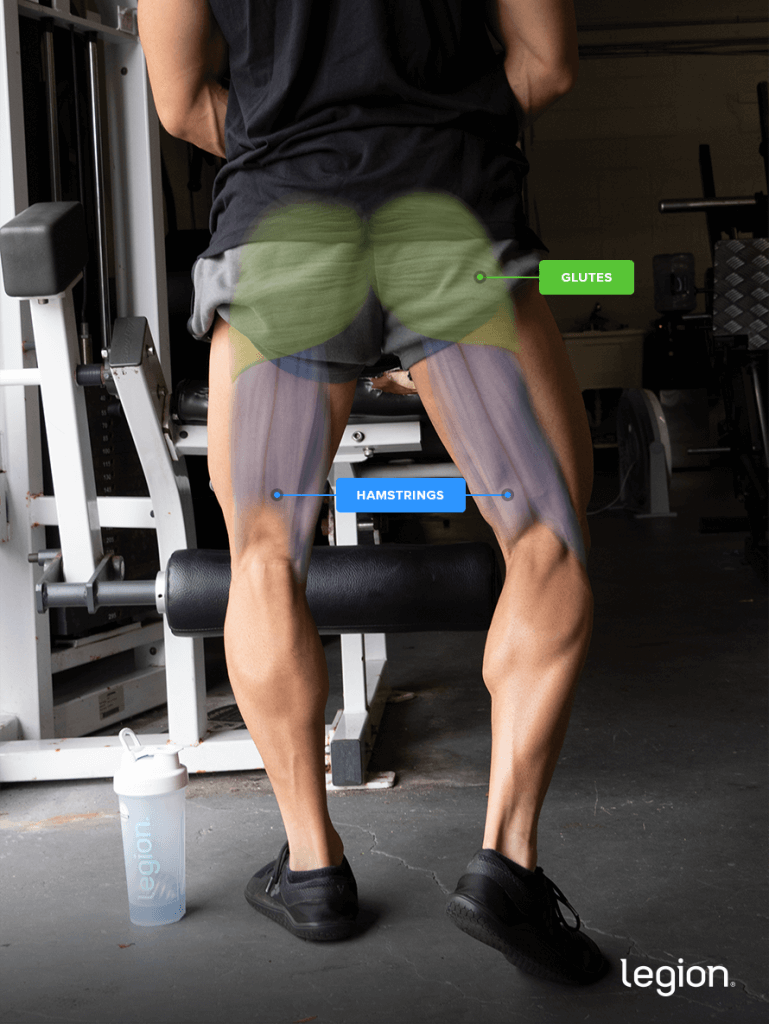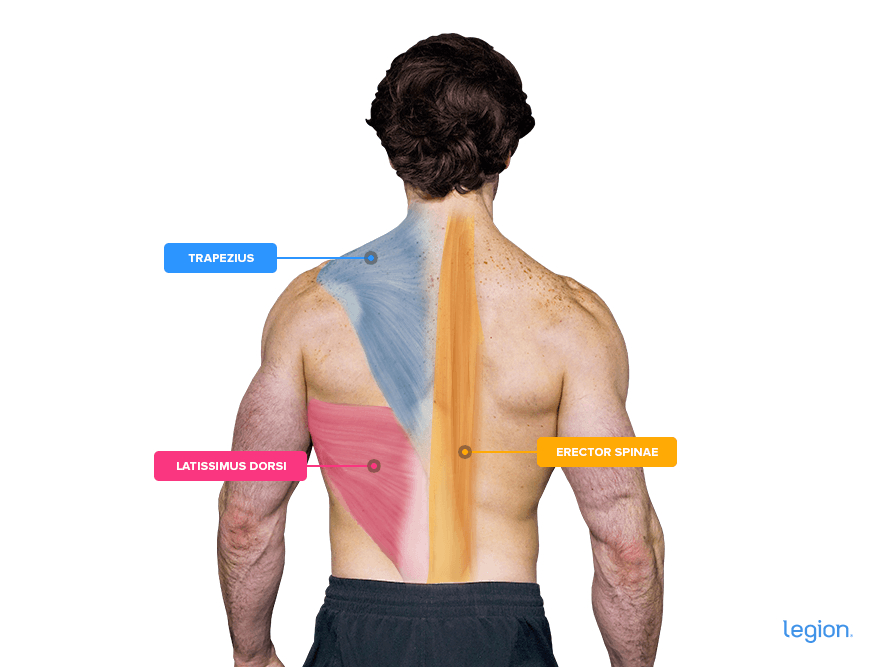The stiff-leg deadlift (or “straight-leg deadlift”) is a deadlift variation that emphasizes your glutes and hamstrings.
It’s useful because it’s less fatiguing than other deadlift variations and allows you to train your hamstrings and glutes with heavy weights and while stretched, making it ideal for muscle growth.
In this article, you’ll learn proper stiff-leg deadlift form, how the stiff-legged deadlift is different from the Romanian deadlift, the best stiff-leg deadlift alternatives and variations, which muscles the exercise works, its benefits, common mistakes to avoid, and more.
How to Do Stiff-Leg Deadlifts
Learning to deadlift stiff-legged isn’t as tricky as it looks. All you need to do to master stiff leg deadlift form is split the exercise into three parts: set up, descend, and lift.
1. Set up
Stand up straight holding a loaded barbell with a shoulder-width, overhand grip (palms facing your body).
Take a deep breath of air into your belly, brace your core, raise your chest, and press your upper arms into your sides as if you were trying to crush oranges in your armpits.
2. Descend
Flatten your back and lower the weights toward the floor in a straight line while keeping your legs almost completely straight, pushing your hips backward as you descend.
Continue lowering the bar until the plates touch the floor.
3. Lift
While keeping your back flat, chest up, and knees almost straight, drive your hips forward while pulling the bar straight up and return to a starting position.
Here’s how it should look when you put it all together:
Romanian Deadlift (RDL) vs. Stiff-Leg Deadlift
The stiff-leg and Romanian deadlifts are similar exercises with a few key differences.
For instance, in the stiff-leg deadlift, you start and finish each rep with the bar on the floor, and your legs stay straighter throughout each rep.
Because of this, the stiff-leg deadlift has a longer range of motion, making it excellent for developing your glutes, hamstrings, and lower back.
The downside is that most people can’t lift as much weight on the stiff-leg deadlift as they can with the Romanian deadlift. Some also find the stiff-leg version difficult to learn and uncomfortable, especially if they have poor flexibility or lower back issues.
The Best Stiff-Leg Deadlift Alternatives and Variations
1. Romanian Deadlift
While both exercises are highly effective for training the hamstrings, glutes, and lower back, the Romanian deadlift has a slightly shorter range of motion than the stiff-leg deadlift, making it more comfortable and easy to learn for many weightlifters.
2. Dumbbell Stiff-Leg Deadlift
Performing the stiff-legged deadlift with dumbbells is almost the same as doing it with a barbell. The only difference is that doing the exercise with dumbbells allows you to extend the range of motion since you can bend forward further without the weights hitting the floor.
The downside is that dumbbells are trickier to control than a barbell, which makes the dumbbell stiff-leg deadlift less suitable for new weightlifters.
3. Eccentric-Accentuated Stiff-Leg Deadlift
The eccentric-accentuated stiff-leg deadlift is almost exactly the same as the regular stiff-leg deadlift. The only difference is you use a slower tempo during the descent. This allows you to spend more time in a stretched position, which may benefit growth.
4. Leg Curl
The leg curl trains your hamstrings without stressing your spine, making it an excellent alternative to the stiff-leg deadlift for those with lower back issues.
5. Nordic Hamstring Curl
The Nordic hamstring curl allows you to train your hamstrings and glutes using only your body weight, so it’s a viable stiff leg deadlift alternative for those with access to minimal equipment.
Stiff-Leg Deadlift: Muscles Worked
The main muscles worked by the stiff-legged deadlift are the . . .
- Hamstrings
- Glutes
- Erector spinae
- Latissimus dorsi
- Trapezius
It also trains smaller muscles like the rhomboids, rear delts, infraspinatus, teres major and minor, and forearms to a lesser degree.
Here’s how the main muscles worked by the stiff-leg deadlift look on your body:


Stiff-Leg Deadlift Benefits
1. It allows you to train your posterior chain without overreaching.
The conventional deadlift is the best exercise for building strength and muscle in your entire posterior chain (the muscles on the back of your body), but it’s also extremely taxing.
The barbell stiff-leg deadlift is a compromise of sorts that lets you train many of the same muscle groups without risking overreaching or injury. That’s why it’s an excellent exercise to include in your routine in addition to regular deadlifting.
2. It trains your hamstrings eccentrically and in a stretched position.
Research shows that exercises that emphasize the eccentric (lowering phase) of each rep and train your muscles while stretched, like the stiff-legged deadlift, are highly effective for building muscle.
While scientists aren’t entirely sure why this is, their current best guess is that emphasizing the eccentric and placing your muscles under load when stretched directly stimulates muscle protein synthesis and greatly increases anabolic (muscle-building) hormones.
3. It allows you to train your hamstring with heavy weights.
Generally speaking, the more weight you lift, the more strength and muscle you gain.
Unfortunately, many hamstring exercises don’t allow you to handle heavy weights.
For example, exercises such as the hamstring curl, hyperextension, and kettlebell swing are great for training the hamstrings, but they’re awkward with heavy weights.
The stiff-leg deadlift, on the other hand, allows you to safely handle heavy weight and progress regularly, which means it’s ideal for building muscle and gaining strength.
Common Stiff-Legged Deadlift Mistakes
1. Allowing the barbell to drift forward.
Letting the barbell drift away from your body increases the odds that you’ll round your back, which can lead to injury. The best ways to avoid this are to focus on keeping the bar close to your body and contracting your upper back and lats throughout each rep.
2. Rounding your back.
Failing to keep your back flat is an error that reduces the effectiveness of the exercise and potentially increases your risk of injury. To avoid rounding your back, focus on pushing your butt backward as you perform the hinging movement to lower the weight.
Also, lift the bar with control—don’t bounce it off the floor or use a jerking motion to help you return to a standing position.
3. Bending your knees too much.
While the stiff-legged deadlift does allow for a slight knee bend, bending them too much turns the exercise into a standard deadlift and shifts the focus away from the target muscles. Aim to keep your legs as straight as your flexibility allows.
Scientific References +
- Boone, Tommy, et al. Journal of Exercise Physiologyonline Editor-In-Chief JEPonline Electromyographic Activity of Lower Body Muscles during the Deadlift and Still-Legged Deadlift. Vol. 16, no. 3, 2013, www.asep.org/asep/asep/JEPonlineJUNE2013_Miranda.pdf.
- Lee, Sangwoo, et al. “An Electromyographic and Kinetic Comparison of Conventional and Romanian Deadlifts.” Journal of Exercise Science & Fitness, vol. 16, no. 3, Dec. 2018, pp. 87–93, https://doi.org/10.1016/j.jesf.2018.08.001.
- Farthing, Jonathan P., and Philip D. Chilibeck. “The Effects of Eccentric and Concentric Training at Different Velocities on Muscle Hypertrophy.” European Journal of Applied Physiology, vol. 89, no. 6, 1 Aug. 2003, pp. 578–586, https://doi.org/10.1007/s00421-003-0842-2.
- Fridén, J., et al. “Adaptive Response in Human Skeletal Muscle Subjected to Prolonged Eccentric Training.” International Journal of Sports Medicine, vol. 04, no. 03, Aug. 1983, pp. 177–183, https://doi.org/10.1055/s-2008-1026031. Accessed 1 May 2019.
- McMahon, Gerard E., et al. “How Deep Should You Squat to Maximise a Holistic Training Response? Electromyographic, Energetic, Cardiovascular, Hypertrophic and Mechanical Evidence.” Www.intechopen.com, IntechOpen, 22 May 2013, www.intechopen.com/chapters/44165. Accessed 26 June 2023.
- Rindom, Emil, et al. “Estimation of P70S6K Thr389 and 4E‐BP1 Thr37/46 Phosphorylation Support Dependency of Tension per Se in a Dose‐Response Relationship for Downstream MTORC1 Signalling.” Acta Physiologica, vol. 229, no. 1, 26 Dec. 2019, https://doi.org/10.1111/apha.13426. Accessed 28 Mar. 2024.
- Eliasson, Jörgen, et al. “Maximal Lengthening Contractions Increase P70 S6 Kinase Phosphorylation in Human Skeletal Muscle in the Absence of Nutritional Supply.” American Journal of Physiology-Endocrinology and Metabolism, vol. 291, no. 6, Dec. 2006, pp. E1197–E1205, https://doi.org/10.1152/ajpendo.00141.2006. Accessed 2 Sept. 2021.
- Franchi, M. V., et al. “Architectural, Functional and Molecular Responses to Concentric and Eccentric Loading in Human Skeletal Muscle.” Acta Physiologica, vol. 210, no. 3, 6 Feb. 2014, pp. 642–654, https://doi.org/10.1111/apha.12225. Accessed 4 May 2020.










